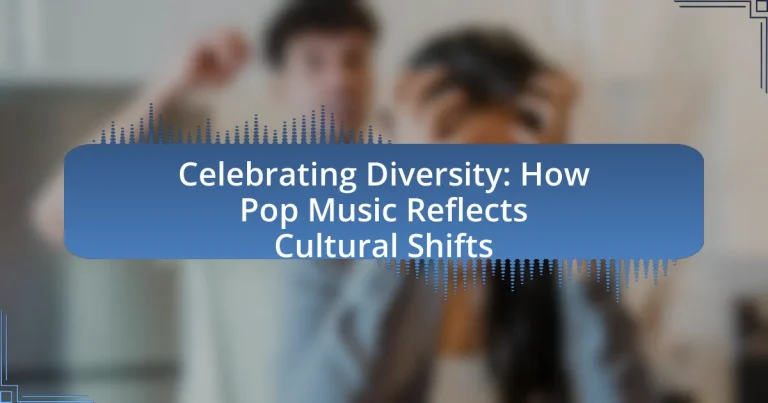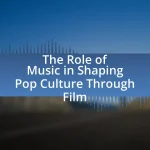The article “Celebrating Diversity: How Pop Music Reflects Cultural Shifts” examines the importance of diversity in pop music and its role in fostering inclusivity and reflecting societal changes. It highlights how artists from various backgrounds contribute unique perspectives, enhancing creativity and promoting cultural understanding. Key discussions include the influence of historical events on pop music evolution, the impact of cultural movements on lyrical themes, and the significance of collaborations between diverse artists. The article also addresses the challenges faced in promoting diversity within the music industry and suggests strategies for celebrating and supporting underrepresented voices in pop music.
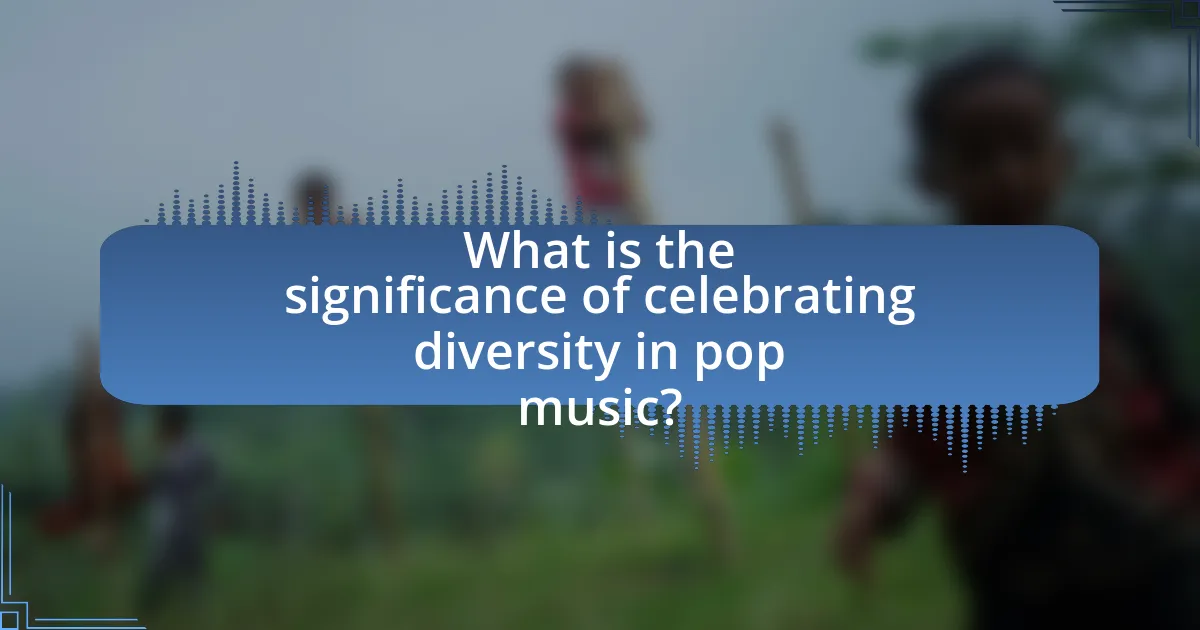
What is the significance of celebrating diversity in pop music?
Celebrating diversity in pop music is significant because it fosters inclusivity and reflects the multicultural landscape of society. This celebration allows artists from various backgrounds to share their unique experiences and perspectives, enriching the genre and broadening its appeal. For instance, the rise of artists like Bad Bunny and BTS has demonstrated how diverse cultural influences can lead to global success, with Bad Bunny bringing reggaeton to mainstream audiences and BTS popularizing K-pop worldwide. Such examples illustrate that embracing diversity not only enhances creativity but also promotes understanding and acceptance among different cultures, making pop music a powerful tool for social change.
How does pop music serve as a reflection of cultural shifts?
Pop music serves as a reflection of cultural shifts by encapsulating societal values, trends, and issues prevalent at specific times. For instance, the rise of hip-hop in the late 20th century mirrored the growing visibility of urban culture and social justice movements, as seen in songs addressing racial inequality and police brutality. Additionally, the incorporation of diverse musical styles and themes in pop music, such as the acceptance of LGBTQ+ identities in tracks by artists like Lady Gaga and Sam Smith, highlights the evolving attitudes towards gender and sexuality. This adaptability of pop music to incorporate and respond to cultural changes demonstrates its role as a barometer for societal transformation.
What historical events have influenced the evolution of pop music?
The evolution of pop music has been significantly influenced by historical events such as the civil rights movement, the rise of technology, and major cultural shifts. The civil rights movement in the 1960s, for instance, led to the emergence of artists like Aretha Franklin and Marvin Gaye, who infused social justice themes into their music, reflecting the struggles and aspirations of marginalized communities. The advent of technology, particularly the introduction of the radio and television, transformed how music was consumed and promoted, allowing artists like Elvis Presley and The Beatles to reach global audiences and shape pop culture. Additionally, the LGBTQ+ rights movement has played a crucial role in the evolution of pop music, with artists like Madonna and Lady Gaga using their platforms to advocate for acceptance and diversity, thereby influencing the genre’s themes and representation. These events collectively illustrate how pop music serves as a mirror to societal changes and cultural shifts.
How do cultural movements shape the themes in pop music?
Cultural movements significantly shape the themes in pop music by influencing the lyrical content, musical styles, and overall messages conveyed by artists. For instance, the civil rights movement in the 1960s led to the emergence of songs that addressed social justice, equality, and empowerment, exemplified by tracks like “A Change Is Gonna Come” by Sam Cooke. Similarly, the LGBTQ+ rights movement has inspired pop anthems that celebrate identity and acceptance, such as Lady Gaga’s “Born This Way,” which promotes self-love and diversity. These examples illustrate how cultural movements not only reflect societal changes but also actively contribute to the evolution of pop music themes, making them a powerful medium for expressing collective experiences and aspirations.
Why is diversity important in the music industry?
Diversity is important in the music industry because it fosters innovation and creativity, leading to a richer and more varied musical landscape. A diverse range of voices and perspectives allows for the exploration of different genres, styles, and cultural influences, which can resonate with broader audiences. For instance, research from the University of Southern California’s Annenberg Inclusion Initiative found that diverse representation in music correlates with increased commercial success, as artists from varied backgrounds often attract wider fan bases and create more relatable content. This inclusivity not only enhances artistic expression but also reflects societal changes, making music a powerful tool for cultural dialogue and understanding.
What impact does diversity have on artist representation?
Diversity significantly enhances artist representation by broadening the range of voices and perspectives in the music industry. This inclusion allows for a richer tapestry of cultural narratives, which can resonate with a wider audience. For instance, the rise of artists from various ethnic backgrounds has led to increased visibility and acceptance of different musical styles, such as reggaeton and K-pop, in mainstream pop music. According to a 2020 report by the Annenberg Inclusion Initiative, only 21.5% of artists in popular music were from underrepresented racial and ethnic groups, highlighting the ongoing need for diversity to improve representation. This shift not only reflects societal changes but also influences the themes and messages conveyed in music, making it more relatable and impactful for diverse audiences.
How does diversity in pop music influence audience engagement?
Diversity in pop music significantly enhances audience engagement by appealing to a broader range of cultural backgrounds and personal experiences. This inclusivity fosters a sense of connection among listeners, as they find representation in the music that resonates with their identities. For instance, a study by the University of Southern California found that songs featuring diverse artists or themes can increase streaming numbers and social media interactions, demonstrating that audiences are more likely to engage with music that reflects their own cultural narratives. This engagement is further amplified by the rise of social media platforms, where diverse pop music can reach global audiences, creating communities around shared musical experiences.
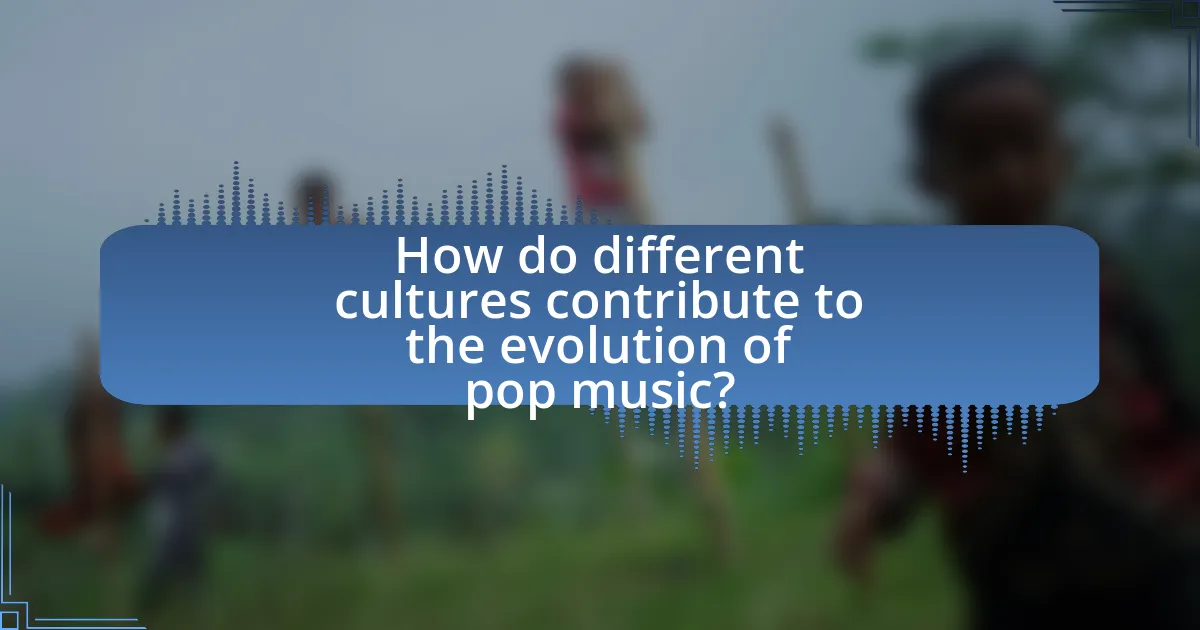
How do different cultures contribute to the evolution of pop music?
Different cultures contribute to the evolution of pop music by introducing diverse musical styles, instruments, and lyrical themes that enrich the genre. For instance, the incorporation of African rhythms and blues into American pop music laid the foundation for rock and roll, while Latin influences have shaped the sound of contemporary pop through genres like reggaeton and salsa. The global exchange of music has led to collaborations that blend traditional elements with modern pop, exemplified by artists like Shakira, who fuses Colombian cumbia with mainstream pop. This cultural interplay not only broadens the appeal of pop music but also reflects societal changes and the interconnectedness of global communities.
What are some key genres that have influenced pop music?
Key genres that have influenced pop music include rock, hip-hop, R&B, and electronic dance music (EDM). Rock music, emerging in the 1950s, introduced a rebellious spirit and strong melodies that shaped pop’s structure. Hip-hop, which gained prominence in the 1980s, brought rhythmic vocal delivery and sampling techniques that transformed pop production. R&B contributed smooth vocal styles and emotional depth, influencing mainstream pop artists since the 1990s. EDM, rising in the 2000s, introduced electronic instrumentation and danceable beats, significantly impacting pop’s sound and performance style. These genres collectively reflect cultural shifts and diversity within the pop music landscape.
How has hip-hop shaped contemporary pop music trends?
Hip-hop has significantly shaped contemporary pop music trends by introducing rhythmic complexity, lyrical storytelling, and a focus on cultural authenticity. The genre’s influence is evident in the incorporation of hip-hop beats and flows into mainstream pop songs, as seen in tracks by artists like Ariana Grande and Justin Bieber, who blend R&B and hip-hop elements. Additionally, hip-hop has popularized the use of sampling, allowing pop artists to draw from a diverse range of musical influences, which enhances the genre’s appeal. According to a 2020 report by Nielsen Music, hip-hop surpassed rock as the most popular genre in the United States, highlighting its dominance in shaping the soundscape of contemporary music. This shift reflects broader cultural changes, as hip-hop often addresses social issues and personal narratives, resonating with diverse audiences and fostering a more inclusive musical landscape.
What role do international music styles play in pop music?
International music styles significantly influence pop music by introducing diverse rhythms, melodies, and cultural elements that enhance its appeal and accessibility. For instance, the incorporation of Latin rhythms in pop songs, such as those by artists like Shakira and J Balvin, has led to the global popularity of reggaeton and Latin pop, evidenced by the success of tracks like “Despacito,” which topped charts worldwide. This blending of styles not only broadens the audience but also reflects cultural shifts, showcasing how globalization allows for the fusion of musical traditions, thereby enriching the pop genre and promoting cross-cultural understanding.
How do collaborations between artists from diverse backgrounds enhance pop music?
Collaborations between artists from diverse backgrounds enhance pop music by introducing a variety of cultural influences, sounds, and perspectives that enrich the genre. This fusion leads to innovative musical styles and broader appeal, as seen in successful collaborations like “Despacito” by Luis Fonsi and Justin Bieber, which combined Latin rhythms with pop sensibilities, resulting in a global hit that topped charts in multiple countries. Such partnerships not only diversify the sound of pop music but also promote cultural exchange, allowing artists to reach wider audiences and challenge traditional genre boundaries.
What are some notable collaborations that highlight cultural diversity?
Notable collaborations that highlight cultural diversity include “Despacito” by Luis Fonsi featuring Daddy Yankee and Justin Bieber, which blends Latin pop with mainstream pop, achieving global success and showcasing the fusion of different musical styles. Another significant collaboration is “Bailando” by Enrique Iglesias featuring Sean Paul, Descemer Bueno, and Gente de Zona, which combines Spanish and English lyrics, reflecting the cross-cultural appeal of Latin music. Additionally, the song “Where Is the Love?” by The Black Eyed Peas addresses social issues through a multicultural lens, featuring diverse artists and promoting unity. These collaborations exemplify how artists from various backgrounds can come together to create music that resonates across cultures, thereby enriching the global music landscape.
How do these collaborations impact the music’s reception globally?
Collaborations in music significantly enhance its global reception by merging diverse cultural influences, which broadens audience appeal. For instance, tracks featuring artists from different backgrounds often achieve higher chart positions and streaming numbers, as seen with the success of “Despacito,” which topped charts worldwide due to its collaboration between Luis Fonsi and Daddy Yankee. This fusion not only attracts fans from various demographics but also fosters cross-cultural appreciation, leading to increased sales and streaming across different regions. Furthermore, collaborations can introduce new genres to wider audiences, exemplified by the rise of K-pop globally, where artists like BTS collaborate with Western musicians, further expanding their reach and influence.
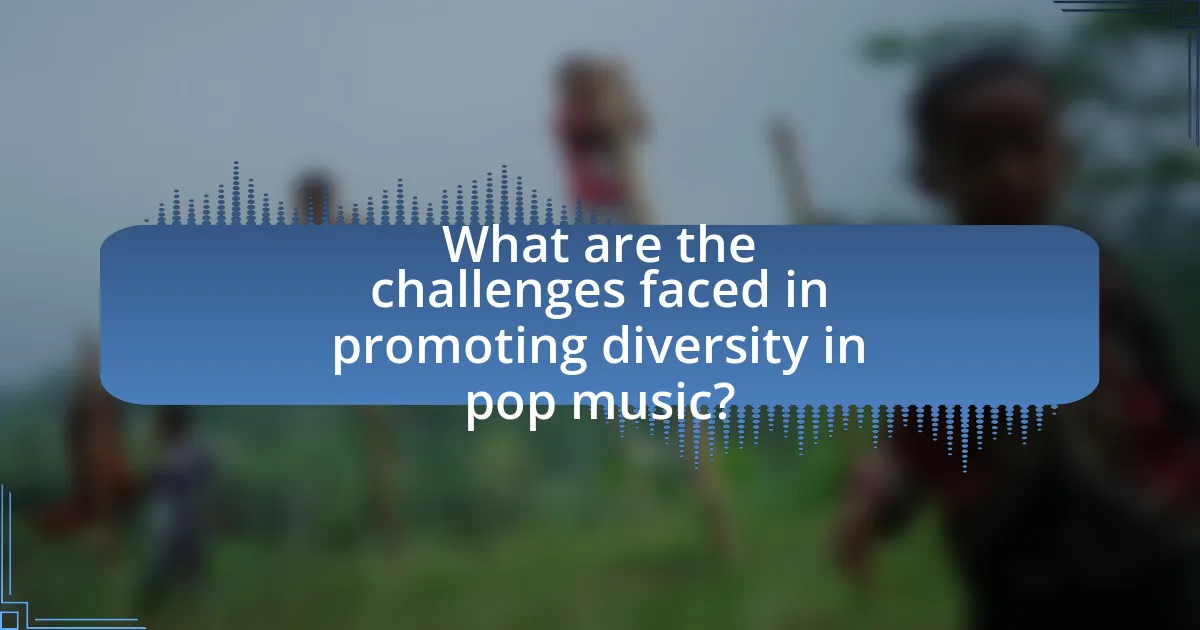
What are the challenges faced in promoting diversity in pop music?
Promoting diversity in pop music faces several challenges, including industry gatekeeping, market pressures, and cultural stereotypes. Industry gatekeeping often limits opportunities for diverse artists, as record labels and producers may favor established norms over innovative sounds. Market pressures can lead to a preference for commercially viable music, which often sidelines diverse voices that do not fit mainstream expectations. Additionally, cultural stereotypes can perpetuate biases, making it difficult for artists from underrepresented backgrounds to gain recognition and support. For instance, a report by the Annenberg Inclusion Initiative found that only 22.5% of artists on the Billboard Hot 100 from 2012 to 2019 were women, highlighting the gender disparity that affects diversity in the genre.
How do industry practices affect diversity in music production?
Industry practices significantly affect diversity in music production by shaping the opportunities available to various artists and influencing the types of music that receive promotion and funding. For instance, major record labels often prioritize commercially viable genres and established artists, which can marginalize underrepresented voices and limit the diversity of sounds in mainstream music. According to a 2021 study by the Annenberg Inclusion Initiative, only 22.5% of artists in popular music were women, highlighting the gender disparity perpetuated by industry norms. Additionally, practices such as playlist curation on streaming platforms can reinforce existing biases, as algorithms may favor familiar sounds over innovative or diverse music styles. This creates a cycle where certain demographics dominate the industry, further stifling diversity in music production.
What barriers do underrepresented artists encounter in the music industry?
Underrepresented artists encounter significant barriers in the music industry, including limited access to funding, lack of representation in decision-making roles, and systemic biases. These barriers hinder their ability to secure contracts, promote their work, and gain visibility. For instance, a report by the Annenberg Inclusion Initiative found that only 21.6% of artists on the Billboard Hot 100 were women, highlighting gender disparities. Additionally, a study by the USC Annenberg School for Communication and Journalism revealed that artists of color face challenges in receiving equitable opportunities compared to their white counterparts. These statistics underscore the systemic obstacles that underrepresented artists must navigate in an industry that often prioritizes established norms and demographics.
How can the industry address these challenges effectively?
The industry can address challenges related to diversity in pop music by implementing inclusive practices and promoting diverse talent. By actively seeking out and supporting artists from various cultural backgrounds, the industry can create a more representative music landscape. For instance, data from the Annenberg Inclusion Initiative indicates that only 21.6% of artists on the Billboard Hot 100 between 2012 and 2020 were women, highlighting the need for targeted initiatives to elevate underrepresented voices. Additionally, establishing partnerships with organizations that advocate for diversity can help ensure that diverse perspectives are integrated into music production and marketing strategies.
What strategies can be implemented to celebrate diversity in pop music?
To celebrate diversity in pop music, artists and producers can implement collaborative projects that feature musicians from various cultural backgrounds. This strategy not only showcases different musical styles and traditions but also fosters cross-cultural understanding. For instance, the collaboration between artists like Shakira and Wyclef Jean in “Hips Don’t Lie” exemplifies how blending diverse influences can create a global hit while promoting cultural appreciation. Additionally, music festivals that highlight diverse lineups, such as the AfroPunk Festival, provide platforms for underrepresented artists, further enriching the pop music landscape. These strategies effectively celebrate diversity by amplifying voices from various communities and encouraging inclusivity within the genre.
How can music festivals promote diverse artists and genres?
Music festivals can promote diverse artists and genres by curating lineups that intentionally include a wide range of musical styles and cultural backgrounds. This approach not only showcases underrepresented artists but also attracts diverse audiences, fostering an inclusive environment. For instance, festivals like Coachella and Glastonbury have made efforts to feature artists from various genres such as hip-hop, electronic, and world music, alongside mainstream pop acts. According to a 2020 report by the Annenberg Inclusion Initiative, festivals that prioritize diversity in their programming can significantly impact the visibility and success of marginalized artists, leading to increased opportunities for collaboration and growth within the music industry.
What role do social media platforms play in supporting diverse voices?
Social media platforms play a crucial role in supporting diverse voices by providing a space for marginalized groups to share their experiences and perspectives. These platforms enable users to create and disseminate content that reflects their cultural identities, fostering a sense of community and belonging. For instance, studies show that social media campaigns, such as #BlackLivesMatter and #MeToo, have amplified the voices of underrepresented communities, leading to increased awareness and social change. Additionally, algorithms on platforms like Instagram and Twitter can promote diverse content, allowing users to discover and engage with a wider range of cultural expressions.
What practical steps can listeners take to support diversity in pop music?
Listeners can support diversity in pop music by actively seeking out and promoting artists from underrepresented backgrounds. This includes exploring music from diverse genres, sharing playlists that feature these artists on social media, and attending concerts or events that highlight multicultural acts. Research indicates that diverse representation in music not only enriches the industry but also reflects broader societal changes, as seen in the rise of artists like Lizzo and Bad Bunny, who have brought unique cultural perspectives to mainstream pop. By engaging with and amplifying these voices, listeners contribute to a more inclusive music landscape.
